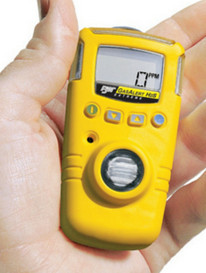A silly question. What is wrong with the detectors for home use, those with the digital display that shows the CO level? The cost is about 30 UKP last time I checked.
Nothing is wrong but they tend to be bulky. Also the display isn't really needed, one doesn't need to know whether it's 100ppm or 200ppm, both are going to kill you. The display is useful to check that it is working -- climbing at Vx with the heating on should give you a positive reading in most aircraft.
I started with a home use detector but then I found this nice and small Pocket CO.
So I bought myself a (quite sensitive) CO monitor to bring along with me in the cockpit. It is a neat little device that I usually strap to one of the safety belts
I noticed (with some surprise) that after a few minutes into the flight I end up with the device showing 20 – 22ppm of CO in the cockpit. It remains stable at this level… no cabin heat engaged! It made me wonder how much CO is “normal” or acceptable to encounter during the flight.. What is your experience or thoughts on this?
cheers
maehhh
I’ve been using it on most of our aeroclub’s fleet, and usually get under 10 ppm in most planes. The Piper Cub gets more (I think around 20), especially when you have the window open in climb or if you use cabin heat. There is one plane where I had to deactivate the alarm at 50 ppm because it wouldn’t stop beeping, but this seems to have been fixed since because now it’s below 10 as well.
You should have received a description of the effects of different concentrations provided with your CO monitor.
I think anything below 50 ppm would not worry me on an absolute scale, but if for example you are below 10 with heat off and then go up to 30 or more with the cabin heat, I would have a mechanic look at it because it may be indicative of an impending problem. Also, the exposure is cumulative because it takes many hours for your body to get rid of the CO. So if you do long flights at high altitudes, then you would want to have lower CO than for short, local flights.
Up to 50ppm is considered to be sustainable for your body.
If it was my airplane, I would would make sure I get close to 0 ppm in cruise. During climb I get 10-20ppm (through the baggage door) and in cruise 0ppm.
What aircraft is this? Values I’ve seen were in the single digit ppms.
From a health perspective it’s probably still ok, since 25ppm seems to be the US exposure limit for an 8 hour workday
maehhh wrote:
So I bought myself a (quite sensitive) CO monitor to bring along with me in the cockpit. It is a neat little device that I usually strap to one of the safety belts
@maehhh, would you please share what device you have bought, preferably with a link to a product description?
I would say a 20ppm reading during normal flight is very serious.
Not because it will kill you or do brain damage during the course of one flight (some people will probably get a headache) but because it indicates something wrong with the exhaust system.
Normally the reading should be zero in the cockpit. I have a BW Gasalert

which is one of the better quality ones and that sometimes shows 20-30ppm when I am landing, if another plane landed just ahead. It beeps when the figure is about something like 25ppm.
Just last week, I was helping my friends get settled in their new flat in Berlin. Seeing a gas-fired water heater directly in the living room and remembering a CO poisoning accident with my ex caused by such a heater, I immediately suggested to install a CO detector. A trip to the nearest baumarkt revealed three wall-mount CO alarms, all priced within €30, two of them with digital indication in ppm.
Well sounds like I should indeed discuss this with the mechanic… CO concentration will increase further to approx 50ppm when cabin heat is engaged. Its a Yakovlev.
Not too worried yet since my flights rarely last for an hour, cabin heat is never used and I do have the monitoring device.. but still!
It is a Draeger Pac 3500 (see http://www.draeger.com/sites/enus_us/Pages/Chemical-Industry/Draeger-Pac-3500.aspx)
